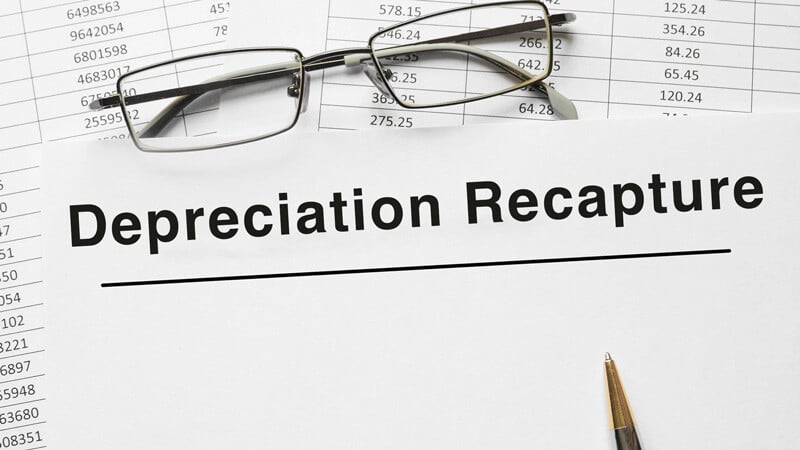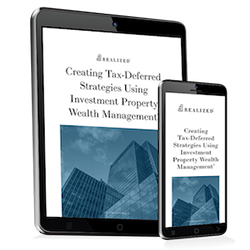
When considering the sale of an appreciated asset, investors have various things to consider. One thing that affects how much they’re going to earn after the transaction is depreciation recapture.
Depreciation is a valuable tool in tax accounting, allowing investors to lower their taxable income as their assets lose their value. However, if you sell an asset, like real estate or machinery and equipment, and receive some profit in the process, then the IRS steps in to recapture the tax reductions you enjoyed in the past — hence the term depreciation recapture.
This concept has a few complexities, and knowing what depreciation recapture entails can help you make better investment decisions. Realized 1031 has shared a guide, so you can get an in-depth understanding of what it is and how it works.
What Is Depreciation Recapture?
Let’s say that you have an apartment complex that initially cost $10 million when you acquired it in 2014. Over the years, you slowly depreciate this real estate asset on account of the wear and tear and the building’s structural integrity and functionality. This process stems from the idea that an asset has a “useful life.” The reduced value allows you to lower the tax basis of the property. When tax season arrives, you pay a lower amount.
However, the IRS has mechanisms to take back these deductions, ensuring that the profit from the sale of an asset isn’t overly sheltered from taxes. Depreciation recapture happens when you sell a depreciated asset and still gain profits.
In our example, the purchase price of the asset was $10 million, and you claimed $4 million in depreciation over its useful life. The adjusted basis is now $6 million. If you were able to sell the property for $8 million, then the $2 million above your adjusted amount is the depreciation recapture amount. It’s subject to taxation at ordinary income tax rates rather than capital gains rates.
Investors usually depreciate any type of capital asset, not just real estate property. These assets include equipment, machinery, and vehicles. However, depreciation recapture is particularly relevant in real estate investing because investors will usually hold and claim depreciation over long periods. If you fail to account for depreciation recapture, you could face significant tax liabilities that could affect your overall profits.
How Depreciation Recapture Works
The main triggering event for depreciation recapture is the sale of a depreciated asset with a gain above the cost-adjusted basis. If you do divest an asset for a loss, you won’t be liable for any tax payments given the capital losses. Otherwise, here’s what you can expect to happen in the depreciation recapture process.
1. Cost-Adjusted Basis
The first step is to determine the cost-adjusted basis for the asset. This value is the original purchase cost minus the depreciation deductions you claimed over the period of ownership. In our example above, $10 million is the purchase cost and $4 million is the deduction. The cost-adjusted basis is now $6 million.
2. Gain on Asset Sale
After determining the adjusted basis, your next step is to calculate the gain. In this case, you subtract the adjusted basis from the final sales price. Let’s say that you’re selling the property above for $8 million. The gain would be $2 million.
3. Recapture Amount
How much of the gain is going to be taxable as ordinary income? You can determine the value by choosing the smaller of these two figures: the realized gain or the accumulated depreciation. In the example above, the realized gain ($2 million) is lower than the accumulated depreciation ($4 million). As such, the realized gain will be subject to ordinary income tax.
If you sold the property for $11 million, then the realized gain is $5 million. In this scenario, the realized gain is higher than the accumulated depreciation. In this case, only $4 million of the gain is subject to depreciation recapture since that’s the equivalent of the claimed depreciation. The remaining $1 million is subject to capital gains taxes.
4. Paying Taxes
Upon identification of the recaptured amount, the next step is to file and pay your dues to the IRS. As we mentioned, the IRS recognizes depreciation recapture value as ordinary income. This category is subject to higher tax rates than capital gains taxes.
The taxes owed on depreciation recapture must be paid when you file your federal income tax return for the year in which the asset was sold. If you sold an asset in 2024, investors must file and pay taxes for depreciation recapture by April 15, 2025. Failing to do so may mean penalties and interest in the unpaid amount.
Why Is the Depreciation Recapture Amount Taxed as Ordinary Income?
There are a few reasons why the IRS categorizes depreciation recapture value as ordinary income. For one, the agency uses this mechanism to recoup tax benefits. Treating the amount as ordinary income allows the government to regain the tax benefits it has provided over the years.
The mechanism also prevents double benefits. Categorizing the recaptured value as capital gains means investors pay at a smaller rate, effectively giving them double tax benefits. There’s also added variance based on the classification of the property. Properties classified as personal property (Section 1245) are typically subject to full recapture at ordinary income rates compared to real properties (Section 1250), which are only partially recaptured, with the remainder potentially taxed at capital gains rates.
How To Calculate Depreciation Recapture
Let’s create a definitive example calculation from the example we shared above: the $10 million apartment complex.
- Original Purchase Price: $10 million
- Accumulated Depreciation: $4 million
- Cost-Adjusted Basis: $10 million – $4 million = $6 million
Now that we have the cost-adjusted basis, the next step is to calculate the gain on sale. In this example, the investor was able to sell the property for a profit because of favorable market conditions. The apartment complex sold for $11 million.
Final Sales Price – Cost-Adjusted Basis = Gain on Sale
$11 million – $6 million = $5 million
Once we have the gain on sale value, the next step is determining the recapture amount and the capital gains. In this case, the gain on sale ($5 million) is higher than the accumulated depreciation ($4 million). This $4 million is the depreciation recapture value and is taxable as ordinary income. The remaining gain on sale ($1 million) is taxable as capital gains.
Ways To Manage Depreciation Recapture Tax Liability
In our example above, the tax liability is considerable. If you belong to higher tax brackets, then your tax rate can reach as high as 37% in some cases. Based on the depreciation recapture value of our example above, you may owe as much as $1,480,000 to the IRS. As such, many investors look for ways to minimize or defer this tax liability. Here are a few options you can try.
1031 Exchange Depreciation Recapture
A 1031 Exchange is one of the more popular methods to defer both capital gains and depreciation recapture taxes. This process is also called the “like-kind” exchange, which allows investors to “swap” their properties for a similar one. Given this mechanism, there is no sale involved, allowing investors to avoid the trigger event that makes them liable to pay depreciation recapture taxes.
One popular method for 1031 Exchanges is through a Delaware Statutory Trust or DST. This is a trust where an investor can exchange the proceeds of sale for interest in the legal entity. It’s the trust that actually owns the property, removing the need for direct management on the investor’s end.
If you choose 1031 Exchange to defer depreciation recapture taxes, make sure that you follow the guidelines set by the IRS, such as the 180-day timeframe and the “like-kind” requirement. You should also note that a 1031 Exchange won’t eliminate taxes. These investment vehicles only defer tax liability, so you will need to pay eventually.
Opportunity Zones and Depreciation Recapture
Another possible option for investors who wish to defer depreciation recapture taxes is to invest in an Opportunity Zone. The Opportunity Zone program designates census tracts that are experiencing economic hardships. When investors put money into a qualified opportunity zone, they enjoy many types of benefits like tax elimination and a high potential for income-generating assets.
Entering an Opportunity Zone investment requires putting your proceeds into a qualified opportunity fund (QOF), which serves as the investment vehicle. If you’re able to hold your investment for a decade or longer, you can actually eliminate your capital gains taxes and depreciation recapture altogether. This tax benefit is possible through the 10-year rule of Opportunity Zones.
While the benefits look appealing, investors must still proceed with a healthy amount of caution for Opportunity Zones. The process of entering a QOF is complex, and there are plenty of other risks that you must take into account before you enter this long-term commitment.
Section 179 and Bonus Depreciation
Section 179 is a revenue code that allows business owners to immediately expense the cost of the new asset rather than depreciate it over several years. Similarly, bonus depreciation enables you to take a large depreciation deduction in the year of purchase. Through these strategies, you can offset some of the taxable income brought about by depreciation recapture. The most popular application of this method is for businesses that need to buy machinery, equipment, and other similar assets.
Installment Sale Agreement
In an installment sale agreement, you enter a contract with a buyer where the latter makes payments over an extended period. Given how you’re only getting gains in increments, you’re only liable to pay smaller amounts. This process helps you avoid paying huge lump sums in one tax year. Plus, if you end up in a lower tax bracket in the next few years, you also reduce your rates, and by extension, your tax payments.
Charitable Remainder Trust
A Charitable Remainder Trust (CRT) is a tax-exempt irrevocable trust designed to reduce taxable income by first dispersing income to the trust beneficiaries for a specified period and then donating the remainder to charity. When you transfer a depreciated asset into a CRT before selling it, you can bypass the immediate tax liability. This method is particularly popular for estate planning and those looking for philanthropic opportunities.
Gifting Depreciated Assets
For broader estate planning strategies, gifting the depreciated asset can help with tax management. This process doesn’t trigger depreciation recapture. Only when the recipient sells the asset will they need to pay taxes. If they belong to a lower tax bracket, then the tax burden will be lower.
Wrapping Up: What You Need To Know About Depreciation Recapture
Depreciation recapture is the tax liability that allows the IRS to recoup tax deductions on a depreciated asset sold with a gain. Given how the depreciation recapture value is taxed as ordinary income, investors like you may need to pay a considerable amount upon the sale of your asset.
It’s important to consider depreciation recapture for more cost-effective tax management practices. Methods like 1031 Exchanges and Opportunity Zone investing are just a few ways to defer and potentially eliminate taxes on depreciation recapture.
For more information about this concept and the strategies we outlined above, Realized 1031 is the team to trust. Contact us today, and let’s talk about your investment goals.
The tax and estate planning information offered by the advisor is general in nature. It is provided for informational purposes only and should not be construed as legal or tax advice. Always consult an attorney or tax professional regarding your specific legal or tax situation.
Sources
https://www.investopedia.com/terms/d/depreciationrecapture.asp
https://www.investopedia.com/terms/s/section1245.asp
https://www.investopedia.com/terms/s/section1250.asp
https://smartasset.com/taxes/current-federal-income-tax-brackets
https://www.irs.gov/credits-deductions/businesses/opportunity-zones



